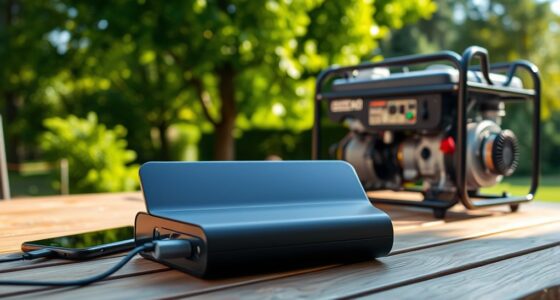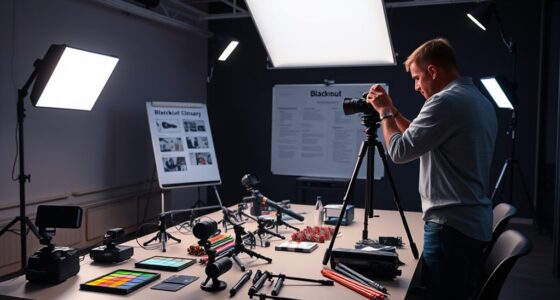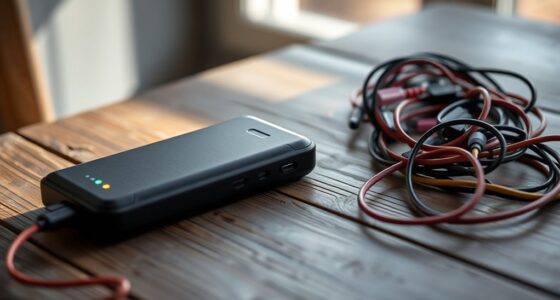To create an effective blackout lighting kit, assemble flashlights, headlamps, and lanterns with extra batteries stored nearby. Test all devices regularly to guarantee they work and keep them in accessible spots like bedrooms or entryways. Organize supplies for quick access and label batteries and lights for easy identification. Remember to follow safety guidelines when handling batteries and avoid overcharging rechargeable ones. For more tips on staying prepared, keep exploring the essential steps for blackout readiness.
Key Takeaways
- Regularly test all lighting devices and batteries to ensure proper functionality during blackouts.
- Keep spare batteries and chargers accessible and organized in designated emergency supply areas.
- Choose lighting options with sufficient brightness and battery life for extended outages.
- Store batteries in cool, dry places and avoid mixing old and new batteries to prevent malfunctions.
- Place lights in visible, accessible locations like entrances and bedrooms for quick deployment in emergencies.
Essential Tips for Blackout Lighting Preparedness

When a blackout hits unexpectedly, having the right lighting kit can make all the difference in keeping your space safe and functional. You want to be prepared so that you can navigate your home or workspace without risking injury or chaos. A reliable lighting kit guarantees you’re not left stumbling in the dark, especially during emergency situations where visibility is critical. It’s important to contemplate battery safety when selecting your lighting solutions. Batteries power many portable lights, but they can pose risks if not handled properly. Avoid mixing old and new batteries, and never use damaged or leaking batteries, as these can cause fires or chemical hazards. Always follow manufacturer instructions for charging and replacing batteries. Proper storage of batteries in a cool, dry place prevents corrosion and prolongs their lifespan, enhancing your emergency preparedness.
In terms of emergency preparedness, it’s wise to have a variety of lighting options on hand. Flashlights, headlamps, and lanterns are essential because they provide focused and widespread light, respectively. Ensure your lights are easy to operate, even in stressful situations, and keep spare batteries nearby. Contemplate rechargeable lights, which are eco-friendly and cost-effective over time, but also keep spare batteries for them. When testing your lighting kit, do so regularly to confirm they’re working properly and that batteries hold a charge. This proactive approach helps you avoid surprises when a blackout occurs. Label and organize your lighting supplies so you can quickly access them in an emergency. Additionally, understanding the role of high-quality lighting in maintaining safety during blackouts can significantly improve your readiness.
Another key aspect of your blackout preparedness involves understanding the placement of your lights. Keep flashlights and lanterns in accessible locations—near entrances, in your bedroom, and in common areas. Charging stations should be set up in visible, easy-to-reach spots, so you can quickly power up your devices if needed. Consider the longevity of your lighting kit; some lights have longer battery life, which is beneficial during extended outages. Remember, safety isn’t only about having light but also about ensuring your batteries are safe to use. Avoid overcharging rechargeable batteries to prevent overheating, and never leave them unattended while charging. Properly maintained batteries and well-organized lighting kits contribute largely to your overall emergency preparedness, giving you confidence that you can handle blackouts efficiently and safely.
Frequently Asked Questions
How Long Do Blackout Lighting Batteries Typically Last?
Blackout lighting batteries usually last between 3 to 8 hours, depending on their battery lifespan and the power backup system’s capacity. If you want longer-lasting light during blackouts, choose batteries with higher capacity and make certain they’re fully charged beforehand. Keep in mind that frequent use or extreme cold can reduce battery lifespan, so it’s smart to have spare batteries ready for extended power outages.
Are Solar-Powered Lighting Kits Reliable During Extended Blackouts?
Yes, solar-powered lighting kits are generally reliable during extended blackouts if you keep up with solar panel maintenance to guarantee efficiency. Regularly clean panels and check connections, and consider battery recycling to replace old batteries before they fail. This proactive approach guarantees your lights stay powered longer, providing peace of mind during prolonged outages. Proper upkeep maximizes the lifespan and performance of your solar lighting system, making it a dependable backup.
Can LED Blackout Lights Be Used Outdoors Safely?
Ever wonder if LED blackout lights are safe outdoors? Yes, they can be, if you choose models with strong outdoor durability and weather resistance. Look for lights specifically designed for outdoor use, ensuring they withstand rain, wind, and temperature changes. Properly installed, these lights provide reliable illumination during blackouts without worry. Are you ready to enjoy safe, effective outdoor lighting even in the toughest weather conditions?
What Safety Precautions Should I Take With Emergency Lighting?
You should always prioritize electrical safety when handling emergency lighting. Keep fire hazards in mind by avoiding overloading circuits or placing lights near flammable materials. Regularly inspect your lighting for damage or loose connections, and verify all cords are in good condition. Use outdoor-rated fixtures if needed, and never operate lights in wet conditions without proper waterproofing. Taking these precautions helps prevent accidents and guarantees your emergency lighting remains safe and effective.
Are There Affordable Blackout Lighting Options Suitable for Large Rooms?
Finding affordable blackout lighting options for large rooms is like searching for a needle in a haystack, but you’re in luck. Portable options and DIY solutions can illuminate big spaces without breaking the bank. Consider LED lanterns, string lights, or rechargeable floodlights, which are budget-friendly and easy to set up. With a bit of ingenuity, you can brighten your entire room efficiently, even during a blackout.
Conclusion
Being prepared with the right blackout lighting kit ensures you’re ready for any dark ages ahead. Remember, even in a world that moves faster than a chariot, a reliable light source keeps you grounded and safe. Keep your checklist handy and don’t forget to test your gear—lest you find yourself in the dark like a cave dweller. Stay prepared, stay bright, and embrace the calm that comes with being ready for whatever the future holds.









